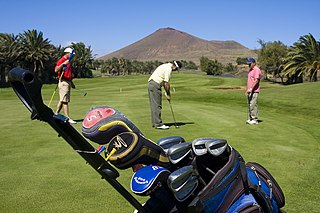Related Research Articles

A sand wedge, or sand iron, is a type of golf club, an open-faced wedge primarily designed for getting out of sand bunkers. It has the widest sole of any wedge, which provides the greatest amount of bounce, allowing the club head to glide through sand and avoid digging in. After Gene Sarazen had success in 1932 with a new club that he had invented for sand play, its popularity quickly grew. The club can be advantageous in other soft lies—such as thick rough, soggy ground, or mud—and is also used from firmer grass lies for lobs or chips.
Harvey Morrison Penick was an American professional golfer and coach, who coached many Hall of Fame players. Late in life, he became a best-selling writer. He was inducted into the World Golf Hall of Fame in 2002, seven years after his death.

Fast bowling is one of two main approaches to bowling in the sport of cricket, the other being spin bowling. Practitioners of pace bowling are usually known as fast bowlers, quicks, or pacemen. They can also be referred to as a seam bowler, a swing bowler or a fast bowler who can swing it to reflect the predominant characteristic of their deliveries. Strictly speaking, a pure swing bowler does not need to have a high degree of pace, though dedicated medium-pace swing bowlers are rarely seen at Test level in modern times.
A golf club is a club used to hit a golf ball in a game of golf. Each club is composed of a shaft with a grip and a club head. Woods are mainly used for long-distance fairway or tee shots; irons, the most versatile class, are used for a variety of shots; hybrids that combine design elements of woods and irons are becoming increasingly popular; putters are used mainly on the green to roll the ball into the hole. A set of clubs is limited by the rules of golf to a maximum of 14 golf clubs, and while there are traditional combinations sold at retail as matched sets, players are free to use any combination of legal clubs.

A golf ball is a special ball designed to be used in the game of golf.
The following is a glossary of the terminology currently used in the sport of golf. Where words in a sentence are also defined elsewhere in this article, they appear in italics. Old names for clubs can be found at Obsolete golf clubs.

In the sport of golf, a wedge is a subset of the iron family of golf clubs designed for special use situations. As a class, wedges have the highest lofts, the shortest shafts, and the heaviest clubheads of the irons. These features generally aid the player in making accurate short-distance "lob" shots, to get the ball onto the green or out of a hazard or other tricky spot. In addition, wedges are designed with modified soles that aid the player in moving the clubhead through soft lies, such as sand, mud, and thick grass, to extract a ball that is embedded or even buried. Wedges come in a variety of configurations, and are generally grouped into four categories: pitching wedges, sand wedges, gap/approach wedges and lob wedges.
In golf, a gap wedge, also known as an approach wedge, is a wedge used to hit a shot with higher and shorter trajectory than a pitching wedge and lower and longer trajectory than a sand wedge. The name derives from the club's design to fill the "gap" between sand and pitching wedges.
A pitching wedge is a wedge used to hit a shot with higher and shorter trajectory than a 9-iron and a lower and longer trajectory than a gap wedge.

In ball sports, topspin or overspin is a property of a ball that rotates forwards as it is moving. Topspin on a ball propelled through the air imparts a downward force that causes the ball to drop, due to its interaction with the air. Topspin is the opposite of backspin.

Macdonald "Mac" Smith was one of the top professional golfers in the world from about 1910 into the mid-1930s. He was a member of a famous Scottish golfing family. Smith is regarded, based on his results, as one of the best golfers of all time who never won a major championship. He won 25 official events on the PGA Tour, and placed in the top ten of major championships a total of 17 times.

Wilson Staff is the golf products division of Wilson Sporting Goods. Wilson designs and manufactures a full range of golf equipment, accessories, and apparel using the Wilson Staff, Wilson, ProStaff, Profile, Ultra and Hope brands. Wilson's other lines are generally considered to be "big box," "value," or "economy" brands, while the Wilson Staff line provides higher quality equipment used on all major professional golf tours.

Golf equipment encompasses the various items that are used to play the sport of golf. Types of equipment include the golf ball, golf clubs, and devices that aid in the sport.

A wood is a type of club used in the sport of golf. Woods have longer shafts and larger, rounder heads than other club types, and are used to hit the ball longer distances than other types.

An iron is a type of club used in the sport of golf to propel the ball towards the hole. Irons typically have shorter shafts and smaller clubheads than woods, the head is made of solid iron or steel, and the head's primary feature is a large, flat, angled face, usually scored with grooves. Irons are used in a wide variety of situations, typically from the teeing ground on shorter holes, from the fairway or rough as the player approaches the green, and to extract the ball from hazards, such as bunkers or even shallow water hazards.

A hybrid is a type of club used in the sport of golf with a design borrowing from both irons and woods while differing from both. The name "hybrid" comes from genetics to denote a mixture of two different species with desirable characteristics of both, and the term here has been generalized, combining the familiar swing mechanics of an iron with the more forgiving nature and better distance of a wood.

The golf swing is the action by which players hit the ball in the sport of golf. The golf swing is a complex motion involving the whole body; the technicalities of the swing are known as golf stroke mechanics.
A lob wedge, also known as a lofted wedge or an L-Wedge, is a wedge used in the sport of golf, known for being one of the shortest-hitting clubs and providing the most loft on a shot. Lob wedges are used to produce shots with a very high arc, and are most often used for shots over hazards and other obstructions. Due to the high arc of the shot the lob wedge, like the other wedges in the set of irons, produces little roll after landing on the putting green and can even be used to produce backspin if necessary. Lob wedges are one of the newest additions to the modern collection of golf clubs and, along with the sand wedge and gap wedge, were not included prior to 1931.
This is a basic glossary of disc golf terms that includes both technical terminology and jargon developed over the years in the sport of disc golf. Where noted, some terms are used only in American English (US), only in British English (UK), or are regional to a particular part of the world, such as Australia (AU).
References
- ↑ "Harvey Penick's Little Red Book, page 155". Simon & Schuster. Retrieved 2015-04-26.